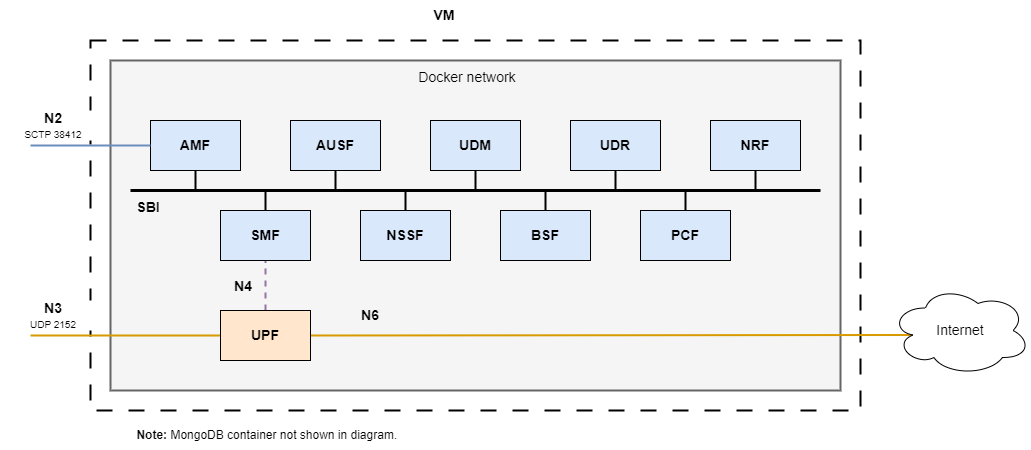Open5GS 5G Core Network Functions images ready for Docker.
This repository contains the Dockerfiles, Docker Compose files and Helm charts to deploy a configurable 5G Core.
The repository uses the same release version tags as Open5GS, so to use an specific Open5GS version just select the appropiate tag.
The Docker images are available for amd64/x86-64 and arm64/v8:
- in DockerHub
borieher/<nf_name>:<open5gs_version> - in GitHub Container Registry
ghcr.io/borjis131/<nf_name>:<open5gs_version>
The Helm charts are available:
- in DockerHub
registry-1.docker.io/borieher/<chart_name> --version <chart_version>
Note
The <chart_version> is not the same as the <open5gs_version>
All the images (except webui) depend on the base-open5gs image to be built, after that each image is independent.
First, update the .env and docker-bake.hcl files with the desired values to use.
The .env file is used to build the images using Make or Docker Compose, as well as deploying in Docker Compose. The docker-bake.hcl file is used to build the images using bake.
OPEN5GS_VERSION is the version of Open5GS to use.
- Accepted values are the tags, branches or commit IDs used in the Open5GS project
- Default value: v2.7.2
- Tested values: v2.5.5, v2.5.6, v2.5.8, v2.6.1, v2.6.2, v2.6.3, v2.6.4, v2.6.6, v2.7.0, v2.7.1, v2.7.2
UBUNTU_VERSION is the version of the ubuntu Docker image used as base for the containers.
- Accepted values are the tags used by Ubuntu in Docker Hub
- Default value: jammy
- Tested values: focal, jammy
MONGODB_VERSION is the version of the mongo Docker image used as database for Open5GS.
- Accepted values are the tags used by MongoDB in Docker Hub
- Default value: The one specified in the
.envfile - Tested values: 3.6.8, 4.2, 6.0
NODE_VERSION is the version of Node.js being used to build the Open5GS WebUI.
- Accepted values are the tags used by Node in Docker Hub for its bookworm-slim image and the Node.js dependency of Open5GS WebUI
- Default value: 20
- Tested values: 20
DOCKER_HOST_IP is the IP address of the host running Docker. This modifies the advertise field in the upf.yaml config file for this to work when exposing the Docker containers network.
Build it with Bake
Tip: This is the recommended way to build the project, you can build the images all at once with a single command taking advantage of docker buildx parallelism
Note: This method uses the
docker-bake.hclfile and requiresdocker-buildx-plugin
From the top level directory of the repository run:
docker buildx bakeBuild it with Make
Note: This method uses the
Makefileand.envfiles
From the top level directory of the repository run the following to create the base-open5gs image and all the Network Function images:
make allThis will take a while.
Build it with Docker Compose
Note: This method uses the
Makefile,.envanddocker-compose.yamlfiles
Some deployments have the build instructions for the images (like the basic deployment), only depending of the base-open5gs image. Some other deployments download the images needed from container registries like Docker Hub or GitHub Container Registry (like the network-slicing deployment).
First create the base-open5gs image, from the top level directory of the repository run:
make base-open5gsThen select the appropiate deployment (basic, scp-model-d or roaming). From the top level directory of the repository, run:
# Example using the basic deployment
docker compose -f compose-files/basic/docker-compose.yaml --env-file=.env up -dThis command builds all the images for the deployment selected and then runs the deployment.
Build the Helm charts
Use the following commands inside the helm/ directory.
First retrieve the dependencies of each chart individually, the open5gs chart must be the latest one, cause it depends on all the other charts:
helm dependency build ./<chart_name>You can also package the charts (it is not mandatory):
helm package ./<chart_name>Use it with Docker Compose
Update the .env file with the desired values to use:
Then select the appropiate deployment and from the top level directory of the repository run:
# Run the basic deployment
docker compose -f compose-files/basic/docker-compose.yaml --env-file=.env up -d
# Tear down the basic deployment
docker compose -f compose-files/basic/docker-compose.yaml --env-file=.env downUse it with Kubernetes
You can download the packaged charts from the repository or you can use the ones built by yourself.
Current CHART_VERSION value for the Open5GS chart is 0.3.2, using OPEN5GS_VERSION v2.7.2 as default.
The CHART_VERSION for individual charts is 0.3.1, using OPEN5GS_VERSION v2.7.2 as default.
To download a chart:
helm pull oci://registry-1.docker.io/borieher/<chart_name> --version <CHART_VERSION>To install a chart run:
helm install -n <namespace> <release_name> ./<chart_name>You can provide your custom values using the helm flag -f and providing a values.yaml file:
helm install -n <namespace> -f values.yaml <release_name> ./<chart_name>If the namespace does not exist, create it by using the helm flag --create-namespace.
To uninstall a chart and remove a namespace run:
helm uninstall -n <namespace> <release_name>
kubectl delete namespace <namespace>compose-files/directory contains different docker compose deployments.configs/directory contains the Open5GS configuration files for each docker compose deployment.docs/directory contains the documentation for this project.images/directory has each Network Function Dockerfile.misc/contains examples and diagrams.
The basic deployment is prepared to work with external gNBs, exposing:
N2control plane interface on the AMF usingSCTP port 38412N3user plane interface on the UPF usingUDP port 2152
It also exposes the MongoDB database using TCP port 27017.
Check docs/ to see the full documentation for the different deployments.
